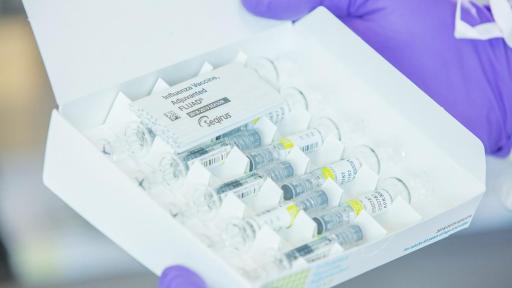Seqirus Begins Shipping 2018-2019 Influenza Vaccines to the U.S. Market
Summit, NJ — [August 8, 2018]
- Seqirus has started to ship its portfolio of more than 50 million doses of influenza vaccines to the U.S. market in preparation for the upcoming 2018-2019 influenza season
- Seqirus utilizes egg and cell-based manufacturing and adjuvant technologies to offer the broadest portfolio of influenza vaccines in the U.S.1
- The Seqirus portfolio includes FLUAD®, the only adjuvanted seasonal influenza vaccine specifically developed for people 65 years and older, and FLUCELVAX® QUADRIVALENT, the most widely available cell-based influenza vaccine in the U.S.
- According to the U.S. Centers for Disease Control and Prevention (CDC), the best way to help prevent influenza is by getting vaccinated each year2
Seqirus announced today it has begun shipping its portfolio of seasonal influenza vaccines to customers in the United States for the 2018-2019 influenza season. Seqirus, one of the largest influenza vaccine companies in the world, and a leading innovator of new technologies, expects to distribute over 50 million doses to the U.S. market this year.
The company will provide FLUAD® (Influenza Vaccine, Adjuvanted), the only adjuvanted seasonal influenza vaccine specifically developed for people aged 65 and older1; and FLUCELVAX® QUADRIVALENT (Influenza Vaccine), the most widely available cell-based influenza vaccine in the country, available for those aged four and older. Ongoing manufacturing innovations have enabled Seqirus, the largest producer of cell-based influenza vaccines in the U.S., to continue to boost production of FLUCELVAX QUADRIVALENT. Almost half of the total doses supplied by the company in the U.S. this season will be FLUCELVAX QUADRIVALENT.
The Seqirus 2018-2019 influenza vaccine portfolio also includes AFLURIA® QUADRIVALENT (Influenza Vaccine), an egg-based quadrivalent influenza vaccine. Seqirus also distributes Rapivab® (peramivir injection), the first-and-only one-dose intravenous antiviral treatment for acute uncomplicated influenza.3-5
The complete portfolio of influenza vaccines provides a range of options for children aged 4 years to people aged 65 years and older, presented in pre-filled syringes as well as multi-dose vials.6-8
Seqirus produces influenza vaccines across its global manufacturing network, which includes a state-of-the-art plant in Holly Springs, North Carolina. This facility utilizes the latest cell-culture technology and was built in partnership with the U.S. government to support pandemic preparedness and emergency response.9
“As the only global vaccine company solely dedicated to the prevention of influenza, Seqirus is committed to partnering with healthcare professionals on the front line of influenza prevention to provide the broadest range of vaccine options as early as possible. We are pleased to build on our track record of early and reliable supply by being one of the first influenza vaccine manufacturers to ship product to the U.S. market during this influenza season,” said Brent MacGregor, Senior Vice President, Commercial Operations at Seqirus.
“Millions of people – particularly those 65 and older, children, and anyone with an underlying medical condition, such as asthma, heart disease, or diabetes, are at increased risk from influenza and its associated complications. According to the CDC, the best way to prevent the flu is by getting vaccinated each year,” said Gregg Sylvester MD, Vice President of Medical Affairs at Seqirus.2,10,11
About the Seqirus Influenza Product Portfolio
FLUAD® (Influenza Vaccine, Adjuvanted)
- FLUAD received approval from the U.S. Food and Drug Administration (FDA) on November 2015 and is the first and only adjuvanted seasonal influenza vaccine in the U.S. for adults aged 65 and older.12
- Age-related decreases in immune function may cause traditional flu vaccines to be less effective in adults 65+. Adults 65 years and older may be less able to fight infection, develop sufficient protective immune responses or generate immunological memory for future protection.12
- FLUAD contains an immune-enhancing adjuvant MF59® thought to boost the immune response.6,12
- In a large pivotal trial, FLUAD elicited strong immune response in adults aged 65+ and has a demonstrated safety profile.6
- The vaccine has an extensive clinical heritage, with more than 102 million doses distributed worldwide since 1997 and licensure in 29 countries.13
Please see the accompanying Important Safety Information and the US full Prescribing Information for FLUAD.
FLUCELVAX® QUADRIVALENT (Influenza Vaccine)
- FLUCELVAX QUADRIVALENT received approval from the FDA on May 23, 2016, making it the first U.S.-licensed cell-based quadrivalent influenza vaccine indicated for people aged 4 years and older.7,14
- The H3N2 and two B components of the 2018-2019 formulation of FLUCELVAX QUADRIVALENT has been produced using a candidate virus that has been isolated in cells, which means these strains are not subjected to egg-mutations.14,15
- FLUCELVAX QUADRIVALENT is available in multi-dose vials and prefilled syringes, offering healthcare providers greater flexibility to determine which vaccine presentation will best meet the needs of their immunization clinics.7
- FLUCELVAX QUADRIVALENT is manufactured at the state-of-the-art facility in Holly Springs, North Carolina, with cell- culture technology, which allows for the potential to rapidly increase production of influenza vaccine in response to outbreaks or pandemic.
- Development of the technology and manufacturing facility that produces FLUCELVAX QUADRIVALENT was supported by strong public-private partnerships with the U.S. government.16
Please see the accompanying Important Safety Information and the US full Prescribing Information for FLUCELVAX QUADRIVALENT.
AFLURIA® QUADRIVALENT (Influenza Vaccine)
- AFLURIA QUADRIVALENT received approval from the FDA for use in persons 5 years of age or older on August 31, 2017.8,17
- The vaccine is available in single-dose, preservative-free pre-filled syringes and multi-dose vials to provide choice and convenience to patients and caregivers who administer it.8
- It is the only quadrivalent flu vaccine with a needle-free injection delivery option (PharmaJet® Stratis® 0.5mL Needle-Free Jet Injector) for persons 18 through 64 years of age.8
Please see the accompanying Important Safety Information and the US full Prescribing Information for AFLURIA QUADRIVALENT.
Rapivab® (peramivir injection)
- Rapivab® is indicated for the treatment of acute uncomplicated influenza in patients 2 years and older who have been symptomatic for no more than 2 days.3
Please see the accompanying Important Safety Information and the US full Prescribing Information for RAPIVAB.
About Seasonal Influenza
Influenza is a common, highly contagious infectious disease that can cause severe illness and life-threatening complications in many people. To reduce the risk of more serious outcomes, such as hospitalization and death, resulting from influenza, the CDC encourages annual vaccination for all individuals aged 6 months and older.2 Because transmission to others may occur one day before symptoms develop and up to 5 to 7 days after becoming sick, the disease can be easily transmitted to others.18
Influenza can lead to clinical symptoms varying from mild to moderate respiratory illness to severe complications, hospitalization and in some cases death.2 The CDC estimates that 310,000 people in the United States were hospitalized due to influenza-related complications during the 2015-2016 influenza season.11 Since it takes about 2 weeks after vaccination for antibodies to develop in the body that protect against influenza virus infection, it is best that people get vaccinated to help protect them before influenza begins spreading in their community.2
About Seqirus
Seqirus is part of CSL Limited (ASX:CSL), headquartered in Melbourne, Australia. The CSL Group of companies employs more than 20,000 people with operations in more than 60 countries.
Seqirus was established on 31 July 2015 following CSL’s acquisition of the Novartis influenza vaccines business and its subsequent integration with bioCSL. As one of the largest influenza vaccine providers in the world, Seqirus is a major contributor to the prevention of influenza globally and a transcontinental partner in pandemic preparedness.
Seqirus operates state-of-the-art production facilities in the U.S., the UK, and Australia, and manufactures influenza vaccines using both egg-based and cell-based technologies. It has leading R&D capabilities, a broad portfolio of differentiated products and a commercial presence in more than 20 countries.
For more information visit www.seqirus.com and www.csl.com.
Seqirus, FLUAD, FLUCELVAX, Afluria, and Rapivab are trademarks of Seqirus UK Limited or its affiliates.
All other trademarks referenced herein are property of their respective owners.
Media Contact
Polina Miklush
+1 (908) 608-7170
[email protected]
References
1. Centers for Disease Control and Prevention (CDC). Influenza vaccines — United States, 2017–18 influenza season. CDC website. https://www.cdc.gov/flu/protect/vaccine/vaccines.htm. Accessed July 2018.
2. CDC. Key facts about seasonal flu vaccine. CDC website. http://www.cdc.gov/flu/protect/keyfacts.htm. Accessed April 2017.
3. Rapivab [package insert]. Summit, NJ: Seqirus USA Inc; 2018.
4. Kohno S, Kida H, Mizuguchi M, Shimada J; S-021812 Clinical Study Group. Efficacy and safety of intravenous peramivir for treatment of seasonal influenza virus infection. Antimicrob Agents Chemother. 2010;54(11):4568-4574.
5. CDC. What you should know about flu antiviral drugs. CDC website. https://www.cdc.gov/flu/antivirals/whatyoushould.htm. Accessed July 2018.
6. FLUAD [package insert]. Summit, NJ: Seqirus USA Inc; 2018.
7. FLUCELVAX QUADRIVALENT [package insert]. Summit, NJ: Seqirus USA Inc; 2018.
8. AFLURIA QUADRIVALENT [package insert]. Summit, NJ: Seqirus USA Inc; 2018.
9. This project has been funded in whole or in part with Federal funds from the Office of the Assistant Secretary for Preparedness and Response, Biomedical Advanced Research and Development Authority, under Contract No. HHSO100200900101C.
10. CDC. People at high risk of developing flu–related complications. CDC website. http://www.cdc.gov/flu/about/disease/high_risk.htm. Accessed on April 2017.
11. CDC. Seasonal influenza-associated hospitalizations in the United States. CDC website. https://www.cdc.gov/flu/about/qa/hospital.htm. Accessed April 2017
12. CDC. FLUAD™ flu vaccine with adjuvant. CDC website. https://www.cdc.gov/flu/protect/vaccine/adjuvant.htm. Accessed July 2018.
13. Seqirus USA Inc. Data on file.
14. CDC. Cell-based flu vaccines. CDC website. https://www.cdc.gov/flu/protect/vaccine/cell-based.htm. Accessed July 2018.
15. World Health Organization. Candidate vaccine viruses and potency testing reagents for development and production of vaccines for use in the southern hemisphere 2018 influenza season. World Health Organization website. http://www.who.int/influenza/vaccines/virus/candidates_reagents/2018_south/en/. Published 2018.
16. U.S. Department of Health & Human Services. A milestone in protection from influenza. U.S. Department of Health and Human Services website. https://wayback.archive-it.org/3926/20150618190057/http://www.hhs.gov/news/press/2014pres/06/20140617a.html. Accessed April 2017.
17. FDA. Vaccines, blood & biologics: AFLURIA QUADRIVALENT. FDA website. https://www.fda.gov/BiologicsBloodVaccines/Vaccines/ApprovedProducts/ucm518291.htm. Accessed July 2018.
18. Centers for Disease Control and Prevention. How flu spreads. Centers for Disease Control and Prevention website. https://www.cdc.gov/flu/about/disease/spread.htm. Updated October 5, 2017. Accessed May 2018.
FLUAD® (Influenza Vaccines, Adjuvanted) Important Safety Information
Indication
FLUAD is an inactivated influenza vaccine indicated for active immunization against influenza disease caused by influenza virus subtypes A and type B contained in the vaccine. FLUAD is approved for use in persons 65 years of age and older.
Contraindications
Severe allergic reaction to any component of the vaccine, including egg protein, or after a previous dose of any influenza vaccine.
Warnings and precautions
- If Guillain-Barré syndrome (GBS) has occurred within six weeks of previous influenza vaccination, the decision to give FLUAD should be based on careful consideration of the potential benefits and risks.
- The tip caps of the prefilled syringes contain natural rubber latex, which may cause allergic reactions in latex-sensitive individuals.
Adverse reactions
- The most common (≥10%) local (injection site) adverse reactions observed in clinical studies were injection site pain (25%) and tenderness (21%).
- The most common (≥10%) systemic adverse reactions observed in clinical studies were myalgia (15%), headache (13%), and fatigue (13%).
For more information, please see accompanying U.S. full Prescribing Information for FLUAD.
FLUCELVAX® QUADRIVALENT (Influenza Vaccine) Important Safety Information
Indication
FLUCELVAX QUADRIVALENT is an inactivated vaccine indicated for active immunization for the prevention of influenza disease caused by influenza A subtype viruses and type B viruses contained in the vaccine. FLUCELVAX QUADRIVALENT is approved for use in persons 4 years of age and older.
Contraindications
- Do not administer FLUCELVAX QUADRIVALENT to anyone with a history of severe allergic reaction (e.g. anaphylaxis) to any component of the vaccine.
Warnings & Precautions
- Guillain-Barré Syndrome (GBS): If GBS has occurred within 6 weeks of receipt of a prior influenza vaccine, the decision to give FLUCELVAX QUADRIVALENT should be based on careful consideration of the potential benefits and risks.
- Preventing and Managing Allergic Reactions: Appropriate medical treatment and supervision must be available to manage possible anaphylactic reactions following administration of the vaccine.
- Syncope: Syncope (fainting) can occur in association with administration of injectable vaccines, including FLUCELVAX QUADRIVALENT. Syncope can be accompanied by transient neurological signs such as visual disturbance, paresthesia, and tonic-clonic limb movements. Procedures should be in place to avoid falling injury and to restore cerebral perfusion following syncope by maintaining a supine or Trendelenburg position.
- Altered Immunocompetence: After vaccination with FLUCELVAX QUADRIVALENT, immunocompromised individuals, including those receiving immunosuppressive therapy, may have a reduced immune response.
- Limitations of Vaccine Effectiveness: Vaccination with FLUCELVAX QUADRIVALENT may not protect all vaccine recipients against influenza disease.
Most Common Adverse Reactions
- The most common (≥10%) local and systemic reactions in adults 18-64 years of age were injection site pain (45.4%), headache (18.7%), fatigue (17.8%), myalgia (15.4%), injection site erythema (13.4%), and induration (11.6%).
- The most common (≥10%) local and systemic reactions in adults ≥65 years of age were injection site pain (21.6%) and injection site erythema (11.9%).
- The most common (≥10%) local and systemic reactions in children 4 to <6 years of age were tenderness at the injection site (46%), injection site erythema (18%), sleepiness (19%), irritability (16%), injection site induration (13%), and change in eating habits (10%).
- The most common (≥10%) local and systemic reactions in children 6 through 8 years of age were pain at the injection site (54%), injection site erythema (22%), injection site induration (16%), headache (14%), fatigue (13%), and myalgia (12%).
- The most common (≥10%) local and systemic reactions in children and adolescents 9 through 17 years of age were pain at the injection site (58%), headache (22%), injection site erythema (19%), fatigue (18%), myalgia (16%), and injection site induration (15%).
Please see accompanying U.S. full Prescribing Information for FLUCELVAX QUADRIVALENT.
AFLURIA® QUADRIVALENT (Influenza Vaccine) Important Safety Information
Indication
AFLURIA QUADRIVALENT is an inactivated influenza vaccine indicated for active immunization against influenza disease caused by influenza A subtype viruses and type B viruses contained in the vaccine. AFLURIA QUADRIVALENT is approved for use in individuals 5 years of age and older.
Contraindications
- Severe allergic reactions (e.g., anaphylaxis) to any component of the vaccine including egg protein, or to a previous dose of any influenza vaccine.
Warnings and Precautions
- If Guillain-Barré Syndrome (GBS) has occurred within 6 weeks of previous influenza vaccination, the decision to give AFLURIA QUADRIVALENT should be based on careful consideration of the potential benefits and risks.
- Appropriate medical treatment and supervision must be available to manage possible anaphylactic reactions following administration of the vaccine.
- Immunocompromised persons may have a diminished immune response to AFLURIA QUADRIVALENT.
Adverse Reactions
- In adults 18 through 64 years, the most commonly reported injection-site adverse reaction when administered by needle and syringe was pain (≥40%). The most common systemic adverse events were myalgia and headache (≥20%).
- In adults 65 years of age and older, the most commonly reported injection-site adverse reaction when administered by needle and syringe was pain (≥20%). The most common systemic adverse event was myalgia (≥10%).
- In children 5 through 8 years, the most commonly reported injection-site adverse reactions when administered by needle and syringe were pain (≥50%), redness and swelling (≥10%). The most common systemic adverse event was headache (≥10%).
- In children 9 through 17 years, the most commonly reported injection-site adverse reactions when administered by needle and syringe were pain (≥50%), redness and swelling (≥10%). The most common systemic adverse events were headache, myalgia, and malaise and fatigue (≥10%).
The safety experience with AFLURIA (trivalent formulation) is relevant to AFLURIA QUADRIVALENT because both vaccines are manufactured using the same process and have overlapping compositions:
- In adults 18 through 64 years of age, the most commonly reported injection-site adverse reactions with AFLURIA (trivalent formulation) when administered by the PharmaJet Stratis Needle-Free Injection System were tenderness (≥80%), swelling, pain, redness (≥60%), itching (≥20%) and bruising (≥10%). The most common systemic adverse events were myalgia, malaise (≥30%), and headache (≥20%).
Please see accompanying U.S. full Prescribing Information for AFLURIA QUADRIVALENT.
RAPIVAB® (peramivir injection) Important Safety Information
Indication
RAPIVAB is indicated for the treatment of acute uncomplicated influenza in patients 2 years and older who have been symptomatic for no more than 2 days.
Limitations of Use
- Efficacy of RAPIVAB is based on clinical trials of naturally occurring influenza in which the predominant influenza infections were influenza A virus; a limited number of subjects infected with influenza B virus were enrolled.
- Influenza viruses change over time. Emergence of resistance substitutions could decrease drug effectiveness. Other factors (for example, changes in viral virulence) might also diminish clinical benefit of antiviral drugs. Prescribers should consider available information on influenza drug susceptibility patterns and treatment effects when deciding whether to use RAPIVAB.
- The efficacy of RAPIVAB could not be established in patients with serious influenza requiring hospitalization.
Contraindications
RAPIVAB is contraindicated in patients with known serious hypersensitivity or anaphylaxis to peramivir or any component of the product. Severe allergic reactions have included anaphylaxis, erythema multiforme and Stevens-Johnson Syndrome.
Warnings and Precautions
- Rare cases of serious skin reactions, including erythema multiforme, have been reported with RAPIVAB in clinical studies and in postmarketing experience. Cases of anaphylaxis and Stevens-Johnson Syndrome have been reported in postmarketing experience with RAPIVAB. Discontinue RAPIVAB and institute appropriate treatment if anaphylaxis or a serious skin reaction occurs or is suspected. The use of RAPIVAB is contraindicated in patients with known serious hypersensitivity or anaphylaxis to RAPIVAB.
- Influenza can be associated with a variety of neurologic and behavioral symptoms that can include events such as hallucinations, delirium, and abnormal behavior, in some cases resulting in fatal outcomes. There have been postmarketing reports (from Japan) of delirium and abnormal behavior leading to injury in patients with influenza who were receiving neuraminidase inhibitors, including RAPIVAB. Because these events were reported voluntarily during clinical practice, estimates of frequency cannot be made, but they appear to be uncommon. These events were reported primarily among pediatric patients. The contribution of RAPIVAB to these events has not been established. Patients with influenza should be closely monitored for signs of abnormal behavior.
- Serious bacterial infections may begin with influenza-like symptoms or may coexist with or occur as complications during the course of influenza. RAPIVAB has not been shown to prevent such complications.
Adverse Reactions
The most common adverse reaction in adults (18 years of age and older) was diarrhea (8% RAPIVAB vs 7% placebo). Lab abnormalities (incidence ≥2%) occurring more commonly with RAPIVAB than placebo were elevated ALT 2.5 times the upper limit of normal (3% vs 2%), elevated serum glucose >160 mg/dL (5% vs 3%), elevated CPK at least 6 times the upper limit of normal (4% vs 2%), and neutrophils <1.0 109/L (8% vs 6%). In a subset of subjects with serious influenza requiring hospitalization treated with RAPIVAB 600 mg as monotherapy (N=101), the following adverse reactions were also reported more frequently with RAPIVAB as compared to placebo: constipation (4% versus 2%), insomnia (3% versus 0%), AST increased (3% versus 2%), and hypertension (2% versus 0%).
The safety profile of RAPIVAB in subjects 2 to 17 years of age was generally similar to that observed in adults. Specific adverse reactions reported in pediatric subjects treated with RAPIVAB (occurring in ≥2% of subjects) and not reported in adults included vomiting (3% versus 9% for oseltamivir), fever and tympanic membrane erythema (2% versus 0%, respectively, for each of these events). The only clinically significant laboratory abnormality (DAIDS Grade 2) occurring in ≥2% of pediatric subjects treated with RAPIVAB was proteinuria by dipstick analysis (3% versus 0% for oseltamivir).
Concurrent Use with Live Attenuated Influenza Vaccine
Antiviral drugs may inhibit viral replication of a live attenuated influenza vaccine (LAIV) and thus may reduce vaccine efficacy). The concurrent use of RAPIVAB with LAIV intranasal has not been evaluated. Because of the potential for interference between these two products, avoid use of RAPIVAB within 2 weeks after or 48 hours before administration of LAIV unless medically indicated.
Please see accompanying US full Prescribing Information for Rapivab.
| Seqirus USA Inc. | |||
| Summit, New Jersey 07901 | © 2018 Seqirus USA Inc. | July 2018 | US/CORP/0718/0085 |







